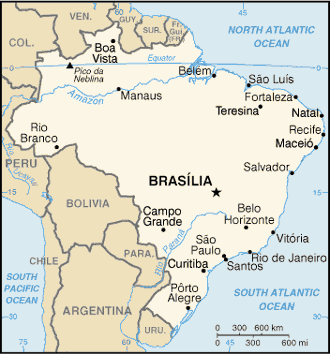World >
South America >
Brazil
Introduction:
|
Following three centuries under the rule of Portugal, Brazil became an independent nation in 1822. By far the largest and most populous country in South America, Brazil has overcome more than half a century of military intervention in the governance of the country to pursue industrial and agricultural growth and development of the interior. Exploiting vast natural resources and a large labor pool, Brazil is today South America's leading economic power and a regional leader. Highly unequal income distribution remains a pressing problem.
|
|
Official name: |
Federative Republic of Brazil
|
|
Capital: |
Brasilia |
|
Government type: |
federative republic |
|
Population: |
182,032,604
note: Brazil took a count in August 2000, which reported a population of 169,799,170; that figure was about 3.3% lower than projections by the US Census Bureau, and is close to the implied underenumeration of 4.6% for the 1991 census; estimates for this country explicitly take into account the effects of excess mortality due to AIDS; this can result in lower life expectancy, higher infant mortality and death rates, lower population and growth rates, and changes in the distribution of population by age and sex than would otherwise be expected (July 2003 est.) |
|
Languages: |
Portuguese (official), Spanish, English, French |
|
Official Currency: |
real (BRL) |
|
Currency code: |
BRL |
|
Area: |
total: 8,511,965 sq km
land: 8,456,510 sq km
note: includes Arquipelago de Fernando de Noronha, Atol das Rocas, Ilha da Trindade, Ilhas Martin Vaz, and Penedos de Sao Pedro e Sao Paulo
water: 55,455 sq km |
|
Climate: |
mostly tropical, but temperate in south |
|
Map of Brazil
|
